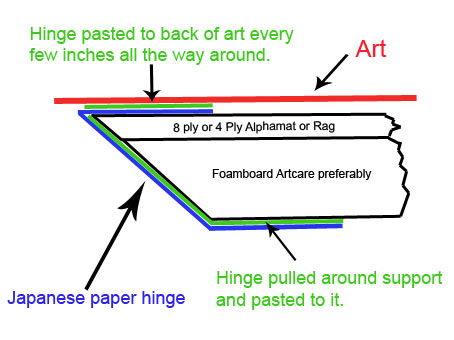The method described below is good for floating art above or onto a background, and would be appropriate for this piece of art. It's a little time consuming but gives an excellent result that is preservation quality in all aspects when appropriate materials are used as it is totally reversible.

- Float.jpg (57.79 KiB) Viewed 7050 times
1. Make the support. It should be about a quarter of an inch smaller than the art. For small jobs, 4 ply is sufficient. For regular larger sizes, 8 ply is excellent. The large piece of art in question is bigger than a sheet of 8 ply, so several pieces of 4ply could be bonded to one large piece of 5mm foamboard. Another layer of 4 ply added to the back of the foamboard would make the entire support much more rigid, which would be desirable on a piece this size. Bevels should be cut on the pieces before assembling the support.
2. Place the art upside down and the support in place on the back of the art. Mark around the edge of the support on the back of the art lightly with a soft pencil. Remove support.
3. Water cut a large batch of hinges, about 1 inch wide and 1.5 to 2 inches long. Make a fold in hinges about 3/8ths to 1/2 inch from the end of a hinge and apply starch paste to that section. Apply hinge to the art with the fold exactly in line with the pencil mark and the excess hinge outside the pencil line. Apply hinges every three inches approx. all the way around the art.
4. When the hinges are all dry, place the support on the back of the art, inside the perimeter of hinges. Apply paste to the inside of the flap of hinge that protrudes, press down on the support so that the art is firmly up against it at the hinge point, then pull the hinge gently and press down to paste the hinge on the bevel and the back of the support. Repeat on remainder of hinges.
Tip: Apply paste to 10 or more hinges at a time and wait until the gloss has gone from the paste before applying the hinge.
Tip: Plastic bags with sand in them make great weights to hold the hinges in place while the paste dries. A piece of non woven synthetic fabric goes on the wet hinge (so the blotting paper doesn't stick), then a piece of blotting paper, then the weight.
Tip: More layers of foamboard can be added to the back of the support to raise the art above the background in the frame.
